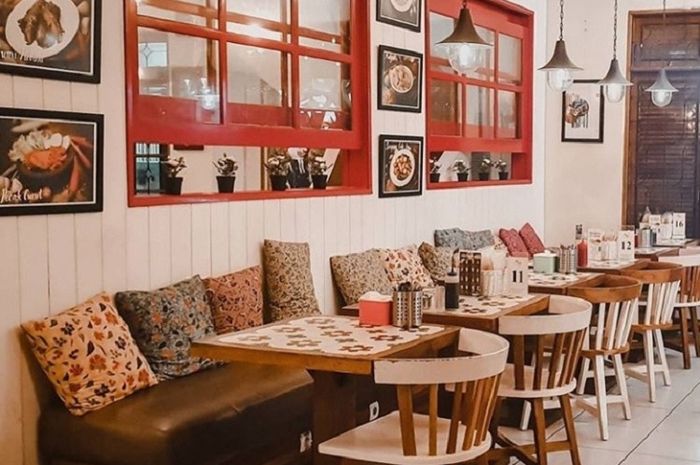
Kitchenesia.com - If I were to describe “Mlinjo” in a song, it is “I knew I loved you before I met you”. It is only getting intensified as I expose myself with its homey and cozy nuance.
Though not exceptionally luxurious, snuggled at Kemuning Street No.50, RW.1, Jatipulo, Palmerah, West Jakarta, “Mlinjo” still alluring with its seemingly frugal view; it proves only the reverse.
As my sight goes on tracing the nook and cranny, I’m especially stuck with the painting on the wall that resembles Javanese queens such as Srikandi. It feels like I’m dragged immediately to another epoch.
Later did I know, it is Ratna’s (the owner of the restaurant) daughter, Yuli’s painting. She took a major in fine art in Nanyang Academy of Fine Art. I’m intrigued to know their underlying reasons the opening of the place.
Yuli tells me that her mother has been so passionate about cooking and I can tell from her eyes, it is vividly projected. One of inspiring figure worth to brag in commemorating International Women’s Day, with the hope of a lot more passionate women will pursue their true calling, just like Ratna with her endless culinary inquiry.
Bring the local gems of Pekalongan to capital
I thought, “Mlinjo” comes up after philosophical enactment of its owner, Ratna. It turns out for the sole reason of the word being such a catchphrase. It consists of only two syllables, “Mli” and “njo”. It hums easily to our ears but will most probably stick in our heads right away; and she couldn’t be more correct with it.
The underlying reasons behind the opening up of “Mlinjo” Café and Resto rather noble, it triggers by the lack of Pekalongan high-end food stalls in capital. So, she later came up with the notion of initiating one.
It came to a realization in 2015, in a scale of test drive at Gajah Mada Plaza before it moved to the current place, in which more spacious so it can cater a lot more costumers unlike the former one.
Refining and preserving the taste of the local cuisines

Nasi megono (Megono rice) and Cumi Hitam (Blank Ink Squid) are two of the most favored Pekalongan cuisines in the restaurant. I don’t usually go along with the most popular in the restaurant but this is an exception, especially for the latter; both of them combined is downright heaven for gustatory excitement.
There are at least 10 types of Megono rice menus offer in Mlinjo, I’m given the privilege to try out two of sorts, those of: Salty Megono Rice with Black Ink Squid (IDR 42,000, consist of salty megono rice, sambal and black ink squid) and Whole Package Megono (IDR 40,000, consist of megono rice with jackfruit topping, stir-fried papaya leaves and black ink squid). The condiments are generously poured in as well, so we won't be left grumbling.
It is like the owner does what she preaches to me, as she wants to introduce Nasi Megono in a more refined way. I’m not in the least betrayed by the taste.
Let alone its aromatic merit that evokes my appetite, it exceeds my expectation towards its rather simple platting. I don’t think with this refined seasoning, though still preserving the authentic taste of megono’s rice somewhat salty and spicy, everyone’s would object a portion of it.
Thick Black Ink of Pekalongan Local Squid for Bolder Aftertaste

The taste of Mlinjo’s very own black squid ink is indescribably savory, almost in a way it is celestial, to exaggerate about it. The saucee has solid black color from the squid ink. It turns out, according to Ratna, it is especially brought directly from Pekalongan, as only Pekalongan’s squid produces thick black color ink.
I especially praise how they mind the texture of their dishes to be munch-friendly. Ratna especially considers elderly, so all the dishes has been steamed for longer time, approximately 1,5 hours, resulted in the foods that are healthier, long-lasting and easy to chew.
Altogether, I strongly suggest those who crave for local cuisine of Pekalangan especially Nasi Megono and Black Ink Quid to eat out at Mlinjo Café and Resto; for topmost experience of recalling the taste with a touch of retro flair. I would love to give 8 out of 10. Though, they can consider in improving the platting of the food to be more aesthetically more pleasing, though doesn’t necessarily have to be as in a European way details.
Other foods and beverages are just as savory like Asam-asam daging (Sour beef stew), Sate Daging, Es Gobet and Es Kacang Ijo (Mung Bean Porridge). By far I’m impressed with their seasoning, everything is decent and carefully thought out. It is the result of expertise and passion combined. Heavenly local cuisines brought out into table.






